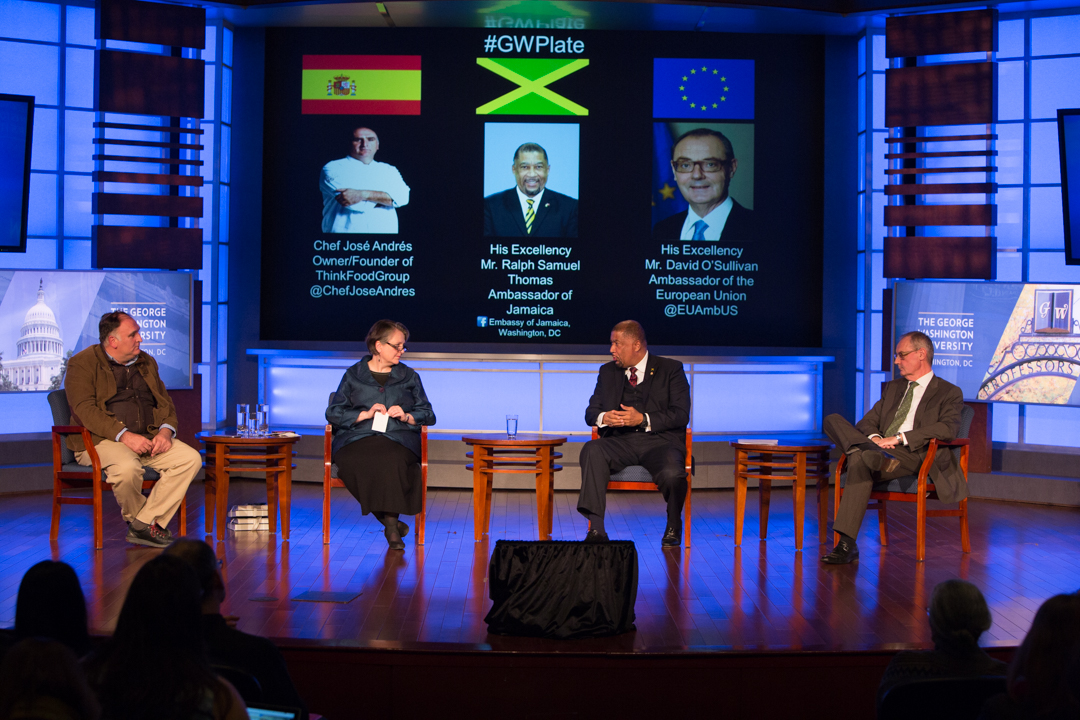In 1826, Mary Randolph’s essential guide to authentic American cooking, “The Virginia Housewife, or Methodical Cook,” was published. More than 200 years later, among the book’s recipes for oyster catsup and rabbit soup, chef and activist José Andrés stumbled upon a recipe for gazpacho, a traditional dish in Spain, his country of birth.
For Mr. Andrés, the book became a symbol of the long-shared, diverse culinary and cultural history of America—a cultural history that he was now a part of as an immigrant-turned-American citizen.
“It was in this book that I found that I belonged to America,” Mr. Andrés told an audience of students, faculty and alumni at the Jack Morton Auditorium Thursday night.
“It’s interesting because it shows that 200 years ago we were sharing our food, our culture—it isn’t new. The question is: ‘Why do we allow some foods to become a part of our culture and not others?’”

The second "Sustainable Plate"event brought Mr. Andrés, Jamaican Ambassador Ralph Thomas and European Union Ambassador David O’Sullivan to the stage (l-r). GW Executive Director of Sustainability Kathleen Merrigan (center) led the discussion.
Mr. Andrés, European Union Ambassador David O’Sullivan and Jamaican Ambassador Ralph Thomas explored the role of food in times that increasingly are globalized during the second session Thursday night of the “Sustainable Plate,” an interdisciplinary undergraduate course at the George Washington University.
The event was hosted by the GW Food Institute. GW Executive Director of Sustainability Kathleen Merrigan, who co-teaches the course with four faculty members, led the discussion.
Food is our “Cultural DNA”
Mr. Andrés said he defines himself as a Spaniard through food—not what he eats, but how he eats it. He described it embodying the spirit of tapas, the small plates enjoyed over several hours, and the tradition of taking a siesta, an afternoon rest that is ingrained in the daily schedule of Spaniards.
“I want to define myself not as the accent, or the language I speak, nor the flamenco or by Hemingway as a young sergeant traveling in Spain,” Mr. Andrés said. “I want to define myself as the sum of all of the amazing foods that Spain puts forward—not recipes, but the way to enjoy them.”
Mr. Andrés recounted how he came face to face with the strength of food as “cultural DNA” while cooking for displaced Haitians in Port-au-Prince two months after the 2010 earthquake. While making black beans and rice, he was approached by a group of women who told him that he couldn’t serve the dish he’d labored over.

Mr. Andrés said that what people cook at home is the center of food culture because it builds traditions within the home that spread.
“The women organized and came to me with a translator and said, ‘José, you cannot serve this, it is no good,’” Mr. Andrés said. “I learned that they had to eat their beans as if they were the perfect French sauce, perfectly skinned and shining.
“Those women taught me that culture is that: to be proud of who you are, even if you are hungry and living in tents that are falling apart under the rain,” Mr. Andrés said. “Your culture is the only thing you have to fight for.”
The cultural division extends to how food is enjoyed, Mr. O’Sullivan said. He related how the U.S. custom of receiving a take-away container for an unfinished meal is unheard of in Europe, despite its sustainable benefits in limiting food waste.
“If in Belgium I leave half my steak on the plate and ask to bring it home, I assure you I would get a most bemused look.”
Mr. O’Sullivan agreed that countries build their cultural heritage and their economies through food. Europe is divided by an invisible culinary line between butter and beer and olive oil and wine, he said. As the European Union grows, the member states continue to support “one market” of free trade and regulation with a respect for each region’s specialty products.
Increasingly, the food economy of European countries is expanding beyond goods to “agritourism,” a section of tourism reliant on enticing visitors with unique, region-based foods such as prosciutto in Parma or feta cheese in Greece.
“There are certain products deeply rooted in a region, and you should be able to protect that,” Mr. O’Sullivan said. “I love Cava, but it’s not champagne.”

Mr. O'Sullivan said that Europe involved itself in the "farm to fork" movement in the 1990s following the outbreak of "mad cow" disease, which prompted a system of checks and balances to track food through production.
Mr. Thomas said Jamaica’s famed Blue Mountain Coffee is an example of how a region gives foods a unique flavor profile.
“It is the same Arabica coffee grown in other places around the world, but the height of the mountains, the soils, the mist, gives it a specific taste and quality,” he said.
Food builds cultural diversity
As cultures fuse, so do food preferences, according to the panelists. For example, Mr. Andrés said, the Portuguese Jesuits introduced tempura to the Japanese in the 1500s, and it became an integral part of food culture. Later, after World War II, Japanese migrants planted seeds for the United States obsession with sushi when they came to the West Coast and brought a love for Japanese food—including tempura—with them.
“We can’t narrow what American food means because diversity is a part of what it means to be American,” Mr. Andrés said. “We have to ask ourselves why do we put up a wall, why up until now is everything called American food, and everything after is ethnic?”
According to Mr. Thomas, indigenous Tainos, British and Spanish colonists, African slaves, laborers from India and Rastafarians have all contributed to building the multicultural food of Jamaica.

Mr. Thomas discussed how Jamaican food and culture has evolved to include flavors from many regions and countries including West Africa, India, Spain and Britain.
“There is no one Jamaican food,” Mr. Thomas said. “Many cultures, many styles have come together.”
For example, Jamaica’s national dish is ackee and saltfish, a combination of the ackee fruit native to West Africa, and saltfish, a salt-cured fresh fish popular in the Caribbean. He added that Jamaica’s famed curry goat was a result of the curry flavors of India meeting the most prevalent animals farmed in Jamaica—goats.
Though the conversation spanned continents, it can be summed by a quote from Mr. Andrés presented at the start of the event beside a photo of the Tex-Mex mash up frito pie that read: “Everything in the end is culture.”


